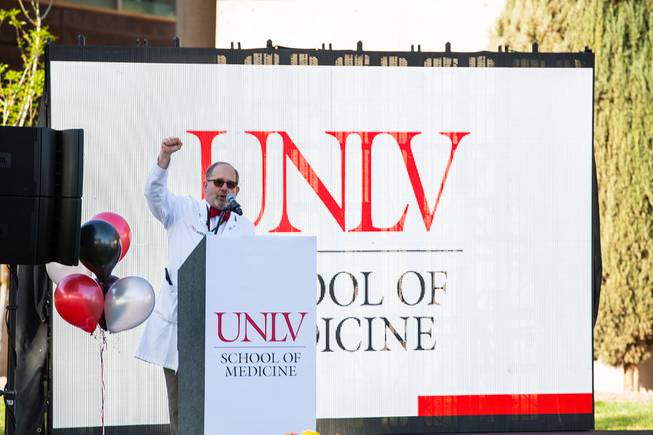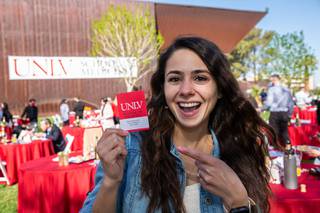
Dr. Marc Kahn, dean of the UNLV School of Medicine, speaks as students gather Friday, March 19, 2021, on the lawn of the Shadow Lane campus for “Match Day” to find out where they have been selected to perform residencies.
Sunday, Jan. 14, 2024 | 2 a.m.
Dr. Marc Kahn, dean of the UNLV’s Kirk Kerkorian School of Medicine, has noticed a trend with many of the medical school’s students: They are leaving Nevada for residency programs out of state.
About 40% of the UNLV med students stay in Nevada to complete a residency or fellowship, Kahn said.
On Match Day 2023 — when graduating medical students learn where they’ll be spending their first year post-graduate training — 26 UNLV med students were pegged for residencies in Nevada. That meant the other 42 graduates from the school’s class of 2023 were heading out of state.
The “woefully inadequate” number of federally-funded residency positions in Nevada has a lot to do with them leaving, Kahn said.
“The way we’re going to increase the number of doctors for our community is with residency and fellowship programs; absolutely critical,” said Kahn, who added, “We need residency programs, or I’m afraid we’ll train people for other states.”
Residencies and fellowships are an important part of a medical student’s training, Kahn said.
Students after graduation must complete three to 10 years of residency, and then pass a national licensing exam before becoming a doctor, he said.
A fellowship, which provides specialty training in a certain field, can also be a final hurdle before some students are licensed to practice, Kahn said.
UNLV sponsors 11 residencies and 11 fellowships recognized by the Accreditation Council for Graduate Medical Education (ACGME), as well as other fellowships accredited by specialty societies.
Some of those residencies include family medicine, internal medicine, plastic surgery and pediatrics. Fellowship programs range from sports medicine to forensic pathology.
Graduating from one of these programs only increases a medical student’s chance that they will stay in the state to practice medicine.
Students who graduate just from a medical school in Nevada have a 40% chance of staying in the state to practice medicine. Med school graduates who complete a residency or fellowship in Nevada have a 60% probability of staying here. Doing both increases the likelihood to 80%, Kahn explained.
Kahn agreed with a recent Intermountain Health study that found getting more medical providers in Nevada can help the region’s medical industry. It’s a simple conclusion: Residencies and fellowships are a good way to retain medical students.
Residencies and fellowships are predominantly funded by the federal government through the Centers for Medicare and Medicaid Services, which had capped the amount of residency positions it would support due to the Balanced Budget Act of 1997. At the time, around 400 positions would be funded in Nevada; for comparison, neighboring California was allowed 9,000, Kahn said.
In 2021, with the passage of the Consolidated Appropriations Act, 1,000 new Medicare-funded residency positions were added nationally for the first time since 1997. And last year’s Resident Physician Shortage Reduction Act of 2023 seeks to increase that to 2,000 positions nationally per fiscal year from 2025 to 2031, according to Congress’ website.
But, according to Kahn, the funding still isn’t there.
If the average resident in a small, three-year program costs about $100,000 per year to support with salary and benefits, Kahn said a 12-resident program could cost $1.2 million.
That’s not even counting faculty to supervise and teach the students, so residency programs can cost a couple million dollars a year, he explained.
If the federal government is hesitant to provide that money, Kahn said states should step up.
It’s why he’s working with Dr. Paul Hauptman, dean of UNR’s School of Medicine, to seek more state-supported residencies.
“If we’re going to increase the number of doctors in our community, the best strategy is we need to increase our residency programs,” Kahn said. “We’re one state, so let’s work for the state and support their growth.”
Kahn is hoping to add more residency and fellowship programs. Kahn said the UNLV medical school just submitted an application to establish a rheumatology fellowship, and it was working with a local group to start an ophthalmology residency.

